Amazon EC2 For WHMCS
(→About Amazon EC2 For WHMCS) |
(→About Amazon EC2 For WHMCS) |
||
| (65 intermediate revisions by 5 users not shown) | |||
| Line 45: | Line 45: | ||
{| | {| | ||
|style="padding: 0px 0px 0px 45px;"|✔ Choose Instance Type | |style="padding: 0px 0px 0px 45px;"|✔ Choose Instance Type | ||
| + | |} | ||
| + | {| | ||
| + | |style="padding: 0px 0px 0px 45px;"|✔ Enable Firewall | ||
|} | |} | ||
{| | {| | ||
| Line 50: | Line 53: | ||
|} | |} | ||
{| | {| | ||
| − | |style="padding: 0px 0px 0px 45px;"|✔ Define | + | |style="padding: 0px 0px 0px 45px;"|✔ Define Number Of Firewall Rules |
|} | |} | ||
{| | {| | ||
| Line 56: | Line 59: | ||
|} | |} | ||
{| | {| | ||
| − | |style="padding: 0px 0px 0px 45px;"|✔ | + | |style="padding: 0px 0px 0px 45px;"|✔ Define Tag Name |
|} | |} | ||
{| | {| | ||
| Line 66: | Line 69: | ||
{| | {| | ||
|style="padding: 0px 0px 0px 45px;"|✔ Toggle API Request Logging | |style="padding: 0px 0px 0px 45px;"|✔ Toggle API Request Logging | ||
| + | |} | ||
| + | {| | ||
| + | |style="padding: 0px 0px 0px 45px;"|✔ Shut Down VM Before Upgrade | ||
| + | |} | ||
| + | {| | ||
| + | |style="padding: 0px 0px 0px 45px;"|✔ Provide User Data Script | ||
| + | |} | ||
| + | {| | ||
| + | |style="padding: 0px 0px 0px 45px;"|✔ Choose User Data File | ||
| + | |} | ||
| + | {| | ||
| + | |style="padding: 0px 0px 0px 45px;"|✔ Choose Subnet | ||
| + | |} | ||
| + | {| | ||
| + | |style="padding: 0px 0px 0px 45px;"|✔ Choose Volume Type | ||
| + | |} | ||
| + | {| | ||
| + | |style="padding: 0px 0px 0px 45px;"|✔ Define Volume Size | ||
| + | |} | ||
| + | {| | ||
| + | |style="padding: 0px 0px 0px 45px;"|✔ Set Volume IOPS | ||
| + | |} | ||
| + | {| | ||
| + | |style="padding: 0px 0px 0px 45px;"|✔ Set Email Template After Server Creation | ||
| + | |} | ||
| + | {| | ||
| + | |style="padding: 0px 0px 0px 45px;"|✔ Select Bandwidth Metrics Period | ||
| + | |} | ||
| + | {| | ||
| + | |style="padding: 0px 0px 0px 45px;"|✔ Define Client Area Configuration | ||
| + | |} | ||
| + | {| | ||
| + | |style="padding: 0px 0px 0px 60px;"|✔ Show Windows Password | ||
| + | |} | ||
| + | {| | ||
| + | |style="padding: 0px 0px 0px 60px;"|✔ Hide DNS Name | ||
| + | |} | ||
| + | {| | ||
| + | |style="padding: 0px 0px 0px 60px;"|✔ Hide Scheduled Tasks | ||
| + | |} | ||
| + | {| | ||
| + | |style="padding: 0px 0px 0px 60px;"|✔ Hide IPv6 | ||
| + | |} | ||
| + | {| | ||
| + | |style="padding: 0px 0px 0px 60px;"|✔ Enable Firewall Configuration | ||
|} | |} | ||
{| | {| | ||
| Line 83: | Line 131: | ||
{| | {| | ||
|style="padding: 0px 0px 0px 30px;"|✔ View Assigned Network Interfaces And IP Addresses Details | |style="padding: 0px 0px 0px 30px;"|✔ View Assigned Network Interfaces And IP Addresses Details | ||
| + | |} | ||
| + | {| | ||
| + | |style="padding: 0px 0px 0px 30px;"|✔ View Scheduled Tasks | ||
| + | |} | ||
| + | {| | ||
| + | |style="padding: 0px 0px 0px 30px;"|✔ Create/Manage Firewall Rules | ||
|} | |} | ||
{| | {| | ||
| Line 88: | Line 142: | ||
|} | |} | ||
{| | {| | ||
| − | |style="padding: 0px 0px | + | |style="padding: 0px 0px 0px 30px;"|✔ Provide SSH Key To Decode Windows Password |
| + | |} | ||
| + | {| | ||
| + | |style="padding: 0px 0px 10px 30px;"|✔ Get/Provide SSH Key For Already Created Instance | ||
|} | |} | ||
| Line 102: | Line 159: | ||
|} | |} | ||
{| | {| | ||
| − | |style="padding: 0px 0px | + | |style="padding: 0px 0px 0px 30px;"|✔ Number Of IPv4 Addresses |
| + | |} | ||
| + | {| | ||
| + | |style="padding: 0px 0px 0px 30px;"|✔ Volume Size [GB] | ||
| + | |} | ||
| + | {| | ||
| + | |style="padding: 0px 0px 0px 30px;"|✔ Volume Type | ||
| + | |} | ||
| + | {| | ||
| + | |style="padding: 0px 0px 0px 30px;"|✔ Number Of Firewall Rules | ||
| + | |} | ||
| + | {| | ||
| + | |style="padding: 0px 0px 10px 30px;"|✔ User Data | ||
|} | |} | ||
*'''General Info:''' | *'''General Info:''' | ||
{| | {| | ||
| − | |style="padding: 10px 0px 0px 30px;"|✔ Integrated With | + | |style="padding: 10px 0px 0px 30px;"|✔ Integrated With [https://www.modulesgarden.com/products/whmcs/server-allocator Server Allocator For WHMCS] - Automatic Assignment Of Most Suitable Servers To Products |
|} | |} | ||
{| | {| | ||
| Line 113: | Line 182: | ||
|} | |} | ||
{| | {| | ||
| − | |style="padding: 0px 0px 0px 30px;"|✔ Supports PHP | + | |style="padding: 0px 0px 0px 30px;"|✔ Supports PHP 8.1 Back To PHP 7.4 |
| + | |} | ||
| + | {| | ||
| + | |style="padding: 0px 0px 0px 30px;"|✔ Supports WHMCS Themes "Six" And "Twenty-One" | ||
|} | |} | ||
{| | {| | ||
| − | |style="padding: 0px 0px 0px 30px;"|✔ Supports WHMCS | + | |style="padding: 0px 0px 0px 30px;"|✔ Supports WHMCS V8.10 Back To WHMCS V8.6 |
|} | |} | ||
{| | {| | ||
| − | |style="padding: 0px 0px 0px 30px;"|✔ | + | |style="padding: 0px 0px 0px 30px;"|✔ Requires ionCube Loader V12 Or Later |
|} | |} | ||
{| | {| | ||
| − | |style="padding: 0px 0px 30px 30px;"|✔ Easy Module Upgrade To [https://www.modulesgarden.com/products/whmcs/amazon-ec2#open-source-version Open Source Version] | + | |style="padding: 0px 0px 30px 30px;"|✔ Easy [https://www.docs.modulesgarden.com/How_To_Upgrade_WHMCS_Module Module Upgrade] To [https://www.modulesgarden.com/products/whmcs/amazon-ec2#open-source-version Open Source Version] |
|} | |} | ||
| Line 146: | Line 218: | ||
{| | {| | ||
|style="padding: 0px 0px 15px 15px;"|'''3. When you install Amazon EC2 For WHMCS for the first time, you have to rename the '' 'license_RENAME.php' '' file.'''<br /> | |style="padding: 0px 0px 15px 15px;"|'''3. When you install Amazon EC2 For WHMCS for the first time, you have to rename the '' 'license_RENAME.php' '' file.'''<br /> | ||
| − | The file is located in '' 'modules/servers/AwsEc2/license_RENAME.php'. '' Rename it from '' 'license_RENAME.php' '' to '' 'license.php'. '' | + | The file is located in '' '/yourWHMCS/modules/servers/AwsEc2/license_RENAME.php'. '' Rename it from '' 'license_RENAME.php' '' to '' 'license.php'. '' |
|} | |} | ||
{| | {| | ||
| Line 161: | Line 233: | ||
{| | {| | ||
|style="padding: 0px 0px 15px 15px;"|'''5. Now, set up the '' 'storage' '' folder as recursively writable.'''<br /> | |style="padding: 0px 0px 15px 15px;"|'''5. Now, set up the '' 'storage' '' folder as recursively writable.'''<br /> | ||
| − | This folder is available at '' '/ | + | This folder is available at '' '/yourWHMCS/modules/servers/AwsEc2/'. '' |
|} | |} | ||
{| | {| | ||
| Line 169: | Line 241: | ||
|style="padding: 0px 0px 30px 15px;"|'''6. The last step is setting up the queue cron job.'''<br /> | |style="padding: 0px 0px 30px 15px;"|'''6. The last step is setting up the queue cron job.'''<br /> | ||
It will be used to execute module commands such as: create, terminate or change package. | It will be used to execute module commands such as: create, terminate or change package. | ||
| − | <pre>php -q / | + | <pre>php -q /yourWHMCS/modules/servers/AwsEc2/cron/cron.php queue</pre> |
It is suggested to run the cron every 5 minutes. | It is suggested to run the cron every 5 minutes. | ||
| Line 198: | Line 270: | ||
|} | |} | ||
{| | {| | ||
| − | |style="padding: 0px 0px 15px 15px;"|'''10. A modal with Access Key Secret Access Key will appear, copy it and keep safe. You may also download a file with the details. '''<br/> | + | |style="padding: 0px 0px 15px 15px;"|'''10. A modal with Access Key ID and Secret Access Key will appear, so copy it and keep safe. You may also download a file with the details. '''<br/> |
Note that this is the only place where you can later on find the corresponding secret key, it will not be visible next to the Key ID in the panel. | Note that this is the only place where you can later on find the corresponding secret key, it will not be visible next to the Key ID in the panel. | ||
|} | |} | ||
| Line 218: | Line 290: | ||
|} | |} | ||
{| | {| | ||
| − | |style="padding: 0px 0px 20px 15px;"|'''13. It is time to create a server group. To do so, click on '' 'Create | + | |style="padding: 0px 0px 20px 15px;"|'''13. It is time to create a server group. To do so, click on '' 'Create New Group' ''.''' |
|} | |} | ||
{| | {| | ||
| Line 267: | Line 339: | ||
{| | {| | ||
|style="padding: 0px 0px 15px 15px;"|'''20. Now, you can start configuring the settings of the server you sell.'''<br /> | |style="padding: 0px 0px 15px 15px;"|'''20. Now, you can start configuring the settings of the server you sell.'''<br /> | ||
| + | <div id="tag_name_20"></div> | ||
Just like when creating a new virtual machine in your EC2 panel, here also you can configure such options as: | Just like when creating a new virtual machine in your EC2 panel, here also you can configure such options as: | ||
* '''Region''' - Choose a geographical area with a set of EC2 resources | * '''Region''' - Choose a geographical area with a set of EC2 resources | ||
| Line 273: | Line 346: | ||
* '''Instance Type''' - Select instance type based on the requirements of the application or software that you plan to run on your instance | * '''Instance Type''' - Select instance type based on the requirements of the application or software that you plan to run on your instance | ||
| + | |||
| + | * '''Firewall''' - If enabled before launching the instance, a separate, dedicated security group will be created for this instance during its creation. <br/> Otherwise, security groups from the Security Groups field will be attached to that instance. | ||
* '''Security Groups''' - A named set of allowed inbound network connections for an instance. Each security group consists of a list of protocols, ports, and IP address ranges | * '''Security Groups''' - A named set of allowed inbound network connections for an instance. Each security group consists of a list of protocols, ports, and IP address ranges | ||
| − | * ''' | + | * '''Number of Firewall Rules''' - Fill in a number of '' 'Firewall Rules' '' that can be set up by a client. |
* '''Number of IPv4 Addresses''' - Enter a maximum number of allowed, public IP addresses (Elastic IP) - once assigned, are not removed when stopping the machine.<br/> If entered "0" value, EC2 will assign a random IP address from one of the default EC2 subnets - such IP is deleted after stopping the machine. | * '''Number of IPv4 Addresses''' - Enter a maximum number of allowed, public IP addresses (Elastic IP) - once assigned, are not removed when stopping the machine.<br/> If entered "0" value, EC2 will assign a random IP address from one of the default EC2 subnets - such IP is deleted after stopping the machine. | ||
| + | |||
| + | * '''Tag Name''' - Define a tag name, this label will be assigned to EC2 resources | ||
* '''User Data''' - You can specify user data to configure an instance or run a configuration script during launch. This field is optional.<br/> Tutorial on how to use this option can be found [https://docs.aws.amazon.com/AWSEC2/latest/UserGuide/user-data.html here]. | * '''User Data''' - You can specify user data to configure an instance or run a configuration script during launch. This field is optional.<br/> Tutorial on how to use this option can be found [https://docs.aws.amazon.com/AWSEC2/latest/UserGuide/user-data.html here]. | ||
| + | |||
| + | * '''User Data File''' - Choose the execution script which will be used to configure the virtual machine on the first boot. Go [[#User_Data_Scripts|here]] to find more information about how to use these scripts.<br/> '' '''Note:''' User Data scripts are '''optional''' for product configuration if you do not want to use them, simply set this field to the 'Do not use' option.'' | ||
| + | |||
| + | * '''Subnet''' - A subnet to which an instance will be launched. | ||
| + | |||
| + | * '''Volume Size''' - Volume size has to be greater than 0. If you do not specify the volume size, the default is the snapshot size. Provisioned IOPS volumes must be at least 100GB in size. | ||
| + | |||
| + | * '''Volume Type''' - General Purpose (SSD) volumes can burst to 3000 IOPS, and deliver a consistent baseline of 3 IOPS/GiB. Provisioned IOPS (SSD) volumes can deliver up to 64000 IOPS and are best for EBS-optimized instances.<br/> Magnetic volumes (previously called standard volumes) can deliver 100 IOPS on average and burst to hundreds of IOPS.<br/> If you want to learn more about volume types, please refer to [https://docs.aws.amazon.com/AWSEC2/latest/UserGuide/ebs-volume-types.html this website]. | ||
| + | |||
| + | * '''Volume IOPS''' - is the requested number of I/O operations per second that the volume can support. For Provisioned IOPS (SSD) volumes, you can provision up to 50 IOPS per GiB. <br/>For General Purpose (SSD) volumes, baseline performance is 3 IOPS per GiB, with a minimum of 100 IOPS and maximum of 16000 IOPS. General Purpose (SSD) volumes under 1000 GiB can burst up to 3000 IOPS. | ||
* ''' Capacity Reservation''' - Capacity Reservations reserve capacity for your EC2 instances in a specific Availability Zone.<br/> You can launch instances into a Capacity Reservation if they have matching attributes (instance type, platform, and Availability Zone), and available capacity | * ''' Capacity Reservation''' - Capacity Reservations reserve capacity for your EC2 instances in a specific Availability Zone.<br/> You can launch instances into a Capacity Reservation if they have matching attributes (instance type, platform, and Availability Zone), and available capacity | ||
| − | * '''Hibernation''' - Enable to allow hibernating your instance. Hibernation stops your instance and saves the contents of its RAM to the root volume.<br/> You cannot enable or disable hibernation after launch<br/> '''''Note:''' It is possible to hibernate only some of the instances. In case your client's machine does not support | + | * '''Hibernation''' - Enable to allow hibernating your instance. Hibernation stops your instance and saves the contents of its RAM to the root volume.<br/> You cannot enable or disable hibernation after launch<br/> '''''Note:''' It is possible to hibernate only some of the instances. In case your client's machine does not support hibernation, this option will be disabled.'' |
* '''Log API Requests''' - Enable to allow storing information on API requests in the '' 'Module Log' '' section in your WHMCS. | * '''Log API Requests''' - Enable to allow storing information on API requests in the '' 'Module Log' '' section in your WHMCS. | ||
| + | |||
| + | * '''Shut Down VM Before Upgrade''' - Automatically shut down a VM before upgrading it, to prevent potential crashes and errors during the upgrade process | ||
| + | |||
| + | * '''Email Template''' - Choose an email template that will be sent to a client when the VM is created. Please refer to [[#Tips|Tips]] section tip 3 to read more about allowed parameters. | ||
| + | |||
| + | * '''Bandwidth Metrics Period''' - Specify bandwidth metrics period by choosing between: | ||
| + | ** 'Current month' | ||
| + | ** 'Last month' | ||
| + | ** 'Based on billing cycle options' <br/ > '''''Note:''' It is advised to set the product billing type to 'Recurring', in case you choose 'One Time', the module will calculate only the past 30 days for bandwidth usage.'' | ||
| + | |||
| + | Client Area Configuration: | ||
| + | |||
| + | * '''Show Windows Password''' - this option works only for Windows instances. After the launch of the instance, password generation and encryption may take up to 15 minutes. | ||
| + | |||
| + | * '''Hide DNS Name''' - if enabled, the '' 'Public DNS Name' '' field will be hidden in the client area. | ||
| + | |||
| + | * '''Hide Scheduled Tasks''' - if enabled, the '' 'Scheduled Tasks' '' section will be hidden in the client area. | ||
| + | |||
| + | * '''Hide IPv6 ''' - If enabled, the '' 'IPv6 Addresses' '' section will be hidden in the client area. | ||
| + | |||
| + | * '''Enable Firewall Configuration''' - If enabled and the instance was created without the '' 'Firewall' '' option enabled, a client will grant the possibility to modify firewall rules. | ||
|} | |} | ||
{| | {| | ||
| Line 295: | Line 403: | ||
Here, you may look for and then select single images to be added to the list. They will be available to choose from in the Amazon Machine Images (AMI) field in the main configuration of the product.<br/> | Here, you may look for and then select single images to be added to the list. They will be available to choose from in the Amazon Machine Images (AMI) field in the main configuration of the product.<br/> | ||
| − | First of all, enter as many details as possible to find the images you are interested in. Press search button when ready. | + | First of all, enter as many details as possible to find the images you are interested in. Press the search button when ready. |
|} | |} | ||
{| | {| | ||
| Line 307: | Line 415: | ||
|} | |} | ||
{| | {| | ||
| − | |style="padding: 0px 0px 20px 15px;"|Enter custom name if you wish and confirm the action. | + | |style="padding: 0px 0px 20px 15px;"|Enter a custom name if you wish and confirm the action. |
|} | |} | ||
{| | {| | ||
| Line 320: | Line 428: | ||
|} | |} | ||
{| | {| | ||
| − | |style="padding: 0px 0px 20px 15px;"|When found, press '' 'Add' '' button. | + | |style="padding: 0px 0px 20px 15px;"|When found, press the '' 'Add' '' button. |
|} | |} | ||
{| | {| | ||
| Line 340: | Line 448: | ||
===SSH Keys=== | ===SSH Keys=== | ||
{| | {| | ||
| − | |style="padding: 10px 0px 15px 15px;"|'''In the '' 'Custom Fields' '' tab you will find | + | |style="padding: 10px 0px 15px 15px;"|'''In the '' 'Custom Fields' '' tab you will find the '' 'SSH Public Key' '' field which is displayed to clients on the [[#Ordering|order form]] by default.'''<br/> |
The following formats are supported: | The following formats are supported: | ||
| Line 353: | Line 461: | ||
#ssh-rsa AAAA[0-9A-Za-z+/]+[=]{0,3}( [^@]+@[^@]+)?# | #ssh-rsa AAAA[0-9A-Za-z+/]+[=]{0,3}( [^@]+@[^@]+)?# | ||
| − | Remember that API allows such action only '''once''', during the initial VM creation. | + | Remember that API allows such action only '''once''', during the initial VM creation. <br/> |
| + | '''Note: If you disable the '' 'Show on Order Form' ''option, a client will not be able to provide SSH Key while placing an order and needs to know the password built into his/her AMI.''' | ||
|} | |} | ||
{| | {| | ||
|style="padding: 0px 0px 30px 25px;"|[[File:AEC_26.png]] | |style="padding: 0px 0px 30px 25px;"|[[File:AEC_26.png]] | ||
| + | |} | ||
| + | |||
| + | ===User Data Scripts=== | ||
| + | {| | ||
| + | |style="padding: 10px 0px 15px 15px;"|User data is arbitrary data that can be executed during Amazon EC2 virtual machine creation, typically during the first boot of the server.<br/>This allows you to perform tasks or run scripts as the root user which can be extremely useful when provisioning a server.<br/> | ||
| + | |||
| + | You can provide your own scripts using 'cloud-config' or 'Bash', keep in mind that [https://developers.whmcs.com/provisioning-modules/module-parameters/ module parameters] are supported and may be used in the script files.<br/> By default, we provide two exemplary scripts for changing the OS password or inserting SSH key, which you can use as a reference.<br/> | ||
| + | The script you want to include has to be located in the '' '/your_whmcs/modules/servers/AwsEc2/storage/userDataFiles/' '' directory and may '''not exceed 64 KiB''' in size. | ||
| + | |} | ||
| + | {| | ||
| + | |style="padding: 0px 0px 20px 25px;"|[[File:AEC_26_1.png]] | ||
| + | |} | ||
| + | {| | ||
| + | |style="padding: 0px 0px 15px 15px;"|Once you create your own script, it can be chosen for product execution.<br/> | ||
| + | You can provide multiple scripts for configurable options, but only one can be chosen for Amazon EC2 server creation.<br/> | ||
| + | If you would like to execute several different scripts at once, you should try combining them within a single file.<br/> | ||
| + | |} | ||
| + | {| | ||
| + | |style="padding: 0px 0px 30px 25px;"|[[File:AEC_26_2.png]] | ||
|} | |} | ||
| Line 363: | Line 491: | ||
{| | {| | ||
|style="padding: 10px 0px 15px 15px;"|''' Amazon EC2 For WHMCS allows you to monitor and manage your customer server instance from the admin area of your WHMCS system.'''<br /> | |style="padding: 10px 0px 15px 15px;"|''' Amazon EC2 For WHMCS allows you to monitor and manage your customer server instance from the admin area of your WHMCS system.'''<br /> | ||
| − | This includes supervision of such features | + | This includes supervision of such features as: |
# Configurable options which enable you to view the chosen server details | # Configurable options which enable you to view the chosen server details | ||
| − | # Module commands to allow easy and quick management of the server<br/> '''''Important:''' In order to successfully complete the change package action, the machine must be previously stopped by your client.'' | + | # Module commands to allow easy and quick management of the server<br/> '''''Important:''' In order to successfully complete the change package action, the machine must be previously stopped by your client (see the [[#Configuration_of_Product|product configuration]] to enable automation).'' <br/> '''''Note:''' When changing the package, a custom security group will be added to the firewall if none has been yet created.'' |
# Service actions, including: ''Start'', ''Stop'' and ''Reboot'' the server | # Service actions, including: ''Start'', ''Stop'' and ''Reboot'' the server | ||
# Instance details that provide the current status, resources and options set. | # Instance details that provide the current status, resources and options set. | ||
# Interfaces details | # Interfaces details | ||
| − | # List of scheduled tasks with | + | # List of scheduled tasks with their specified type, status and date. |
|} | |} | ||
{| | {| | ||
| Line 377: | Line 505: | ||
==Ordering== | ==Ordering== | ||
{| | {| | ||
| − | |style="padding: 10px 0px 15px 15px;"| | + | |style="padding: 10px 0px 15px 15px;"|Thanks to configurable options, you are able to offer a product which your clients can tailor according to their needs.<br />Additionally, you are able to set up pricing for each configurable option, which makes your offer even more competitive.<br/> |
At this moment you also have to provide the [[#SSH Keys|SSH key]]. Note that this key should be in one of the ''OpenSSH'' standard formats which are supported by API, e.g. ''ssh-rsa''.<br/> | At this moment you also have to provide the [[#SSH Keys|SSH key]]. Note that this key should be in one of the ''OpenSSH'' standard formats which are supported by API, e.g. ''ssh-rsa''.<br/> | ||
| Line 383: | Line 511: | ||
{| | {| | ||
|style="padding: 0px 0px 30px 25px;"|[[File:AEC_28.png]] | |style="padding: 0px 0px 30px 25px;"|[[File:AEC_28.png]] | ||
| + | |} | ||
| + | ===Importing Existing Instance=== | ||
| + | {| | ||
| + | |style="padding: 10px 0px 15px 15px;"|In this section, you can find short instruction on how to connect one of your clients to your already existing instance in the Amazon EC2 panel. <br/> Take the following steps to make sure that the process will be carried out properly. <br/> | ||
| + | 1. Firstly, manually create an order for your customer in WHMCS. Choose a client and in the summary, view click on the '' ' Add New Order' '' button. Next, select a '' 'Product/Service' '' and press '' 'Submit Order' ''. <br/> '''What is important, do not perform the '' 'Create' '' action.''' The status has to remain as '' 'Pending' ''. <br/> More info about placing orders can be found [https://docs.whmcs.com/Order_Management#Placing_an_Order here]<br/> | ||
| + | 2. Proceed to the newly created product's card in your admin area. Find the following empty fields: | ||
| + | *'''Instance ID''' | ||
| + | The above-mentioned information has to be consistent with the data from your Amazon EC2 panel. Now, complete these fields as presented below. <br/> '''Important!''' Remember to make sure that the format of the provided data is compatible with the format supported by the module. You can preview it for another product of the module you have already created and enter it in a similar way. <br/> If you completed the required data, now change the status from '' 'Pending' '' to '' 'Active' '' and '' 'Save Changes' ''. | ||
| + | |} | ||
| + | {| | ||
| + | |style="padding: 0px 0px 20px 25px;"|[[File:AmazonEC2_import.png]] | ||
| + | |} | ||
| + | {| | ||
| + | |style="padding: 0px 0px 15px 15px;"|3. If the completed data is correct, after refreshing the page, you will see the attached instance from Amazon EC2. <br/> '''Important!''' Remember to manually add other missing parameters of the instance such as domains, credentials, IP Addresses, configurable options, SSH Key, billing cycle, etc. so they match the parameters of the attached instance from Amazon EC2. | ||
|} | |} | ||
==Client Area== | ==Client Area== | ||
{| | {| | ||
| − | |style="padding: 10px 0px 15px 15px;"| | + | |style="padding: 10px 0px 15px 15px;"|The client area interface of Amazon EC2 should look like the one on the screen below.<br/>As you can see, the control panel contains useful details of the managed server.<br /> |
The module allows your customers to easily start, stop and reboot their server instance through pressing the corresponding buttons.<br /> | The module allows your customers to easily start, stop and reboot their server instance through pressing the corresponding buttons.<br /> | ||
Clients can also check the server status with its details, view assigned network interfaces and assigned IP addresses details as well as control the list of currently scheduled tasks. | Clients can also check the server status with its details, view assigned network interfaces and assigned IP addresses details as well as control the list of currently scheduled tasks. | ||
| Line 393: | Line 535: | ||
{| | {| | ||
|style="padding: 0px 0px 30px 25px;"|[[File:AEC_29.png]] | |style="padding: 0px 0px 30px 25px;"|[[File:AEC_29.png]] | ||
| + | |} | ||
| + | ===Firewall Rules=== | ||
| + | {| | ||
| + | |style="padding: 10px 0px 15px 15px;"|Under the '' 'Firewall Rules' '' section, you may quickly add as well as remove '' 'Firewall Rules' ''. <br/> '''Note:''' ''Please remember that if the 'Add' button is unavailable, you have probably reached the rule limit set by the administrator. '' | ||
| + | |} | ||
| + | {| | ||
| + | |style="padding: 0px 0px 20px 25px;"|[[File:AEC_30.png]] | ||
| + | |} | ||
| + | {| | ||
| + | |style="padding: 0px 0px 15px 15px;"|Complete the details of your new security group rule and confirm by clicking '' 'Add' ''. | ||
| + | |} | ||
| + | {| | ||
| + | |style="padding: 0px 0px 30px 25px;"|[[File:AEC_31.png]] | ||
|} | |} | ||
=Tips= | =Tips= | ||
{| | {| | ||
| − | |style="padding: 10px 0px 10px 15px;"|1. You must | + | |style="padding: 10px 0px 10px 15px;"|1. You must firstly stop the machine to let the change package action be successfully completed. |
|} | |} | ||
{| | {| | ||
| − | |style="padding: 0px 0px | + | |style="padding: 0px 0px 5px 15px;"|2. In case you need to generate any of the configurable options once again, you must delete the previously created one.<br/> Only then it will be possible to generate a new configurable option. Read more about configurable options [https://www.docs.modulesgarden.com/General#How_To_Use_Configurable_Options here]. |
| + | |} | ||
| + | {| | ||
| + | |style="padding: 0px 0px 5px 15px;"|3. Amazon EC2 module supports all the default WHMCS marge field variables, they can be freely used in the welcome email template. Read more about module parameters [https://developers.whmcs.com/provisioning-modules/module-parameters/ here].<br/> | ||
| + | The module also supports the below listed AWS variables: | ||
| + | |||
| + | 'AmiLaunchIndex', 'ImageId', 'InstanceId', 'InstanceType', 'KeyName', 'Monitoring_State', 'Placement_AvailabilityZone', 'Placement_GroupName', 'Placement_Tenancy', 'PrivateDnsName', 'PrivateIpAddress', 'ProductCodes', | ||
| + | 'PublicDnsName', 'State_Code', 'State_Name', 'StateTransitionReason', 'SubnetId', 'VpcId', 'Architecture', 'BlockDeviceMappings', 'ClientToken', 'EbsOptimized', 'EnaSupport', 'Hypervisor', | ||
| + | 'NetworkInterfaces_0_Attachment_AttachmentId', 'NetworkInterfaces_0_Attachment_DeleteOnTermination', 'NetworkInterfaces_0_Attachment_DeviceIndex', 'NetworkInterfaces_0_Attachment_Status', 'NetworkInterfaces_0_Description', | ||
| + | 'NetworkInterfaces_0_Groups_0_GroupName', 'NetworkInterfaces_0_Groups_0_GroupId', 'NetworkInterfaces_0_Ipv6Addresses', 'NetworkInterfaces_0_MacAddress', 'NetworkInterfaces_0_NetworkInterfaceId', 'NetworkInterfaces_0_OwnerId', | ||
| + | 'NetworkInterfaces_0_PrivateDnsName', 'NetworkInterfaces_0_PrivateIpAddress', 'NetworkInterfaces_0_PrivateIpAddresses_0_Primary', 'NetworkInterfaces_0_PrivateIpAddresses_0_PrivateDnsName', | ||
| + | 'NetworkInterfaces_0_PrivateIpAddresses_0_PrivateIpAddress', 'NetworkInterfaces_0_SourceDestCheck', 'NetworkInterfaces_0_Status', 'NetworkInterfaces_0_SubnetId', 'NetworkInterfaces_0_VpcId', 'NetworkInterfaces_0_InterfaceType', | ||
| + | 'RootDeviceName', 'RootDeviceType', 'SecurityGroups_0_GroupName', 'SecurityGroups_0_GroupId', 'SourceDestCheck', 'StateReason_Code', 'StateReason_Message', 'Tags_0_Key', 'Tags_0_Value', 'Tags_1_Key', 'Tags_1_Value', | ||
| + | 'VirtualizationType', 'CpuOptions_CoreCount', 'CpuOptions_ThreadsPerCore', 'CapacityReservationSpecification_CapacityReservationPreference', 'HibernationOptions_Configured', 'MetadataOptions_State', 'MetadataOptions_HttpTokens', | ||
| + | 'MetadataOptions_HttpPutResponseHopLimit', 'MetadataOptions_HttpEndpoint' | ||
| + | |||
| + | |} | ||
| + | {| | ||
| + | |style="padding: 0px 0px 5px 15px;"|4. Utilizing the '' 'Show Windows Password' '' option in the Client Area: | ||
| + | * To enable the "Show Windows Password" option, navigate to Module Settings → Client Area Configuration. | ||
| + | * During the order placement, the client needs to provide the SSH Public Key in a designated field. | ||
| + | * Wait for the completion of the '' 'Loading Windows Password' '' cron process (up to 15 minutes). | ||
| + | * Under "Service Actions," the client should press the '' 'Get Windows Password' '' button and input their Private Key. Subsequently, press the '' 'Get Password' '' button. | ||
| + | * The Windows password should now be visible. | ||
| + | |} | ||
| + | {| | ||
| + | |style="padding: 0px 0px 30px 15px;"|5. When creating a virtual machine without a firewall but with a security group (other than the default), you won't be able to activate the firewall rules through the module.<br/> This action is only possible directly within the panel. | ||
|} | |} | ||
=Update Instructions= | =Update Instructions= | ||
{| | {| | ||
| − | |style="padding: 10px 0px 30px 15px;"| | + | |style="padding: 10px 0px 30px 15px;"|An essential guidance through the process of updating the module is offered '''[https://www.docs.modulesgarden.com/How_To_Update_WHMCS_Module here]'''.<br/> |
| − | + | Ensure successful completion of the module update by carefully following each step, thereby preventing data loss or any unforeseen issues.<br/> | |
| − | + | Additionally, you will find a current list of supplementary actions necessary for a smooth update process there. | |
|} | |} | ||
| + | =Upgrade Guide= | ||
| + | {| | ||
| + | |style="padding: 10px 0px 30px 15px;"|Seeking a solution that offers greater flexibility, customization tailored to your precise needs, and unrestricted availability?<br/> There is an option that not only proves to be cost-effective in the long run but also includes prioritized support services, making it a truly valuable investment.<br/> | ||
| + | |||
| + | Opt for the [https://www.modulesgarden.com/products/whmcs/amazon-ec2#open-source-version Open Source version] of your Amazon EC2 For WHMCS module to unlock these benefits.<br/> Simply click on either the '''Get Source Code''' or '''Upgrade To Lifetime''' button found on the product's page in our client area to complete the one-step upgrade process, with a '''dedicated discount''' already applied.<br/> | ||
| + | |||
| + | Follow a [https://www.docs.modulesgarden.com/How_To_Upgrade_WHMCS_Module comprehensive guide] covering the transition process, the advantages it brings, and step-by-step instructions on what to do next after the order has been successfully finalized. | ||
| + | |} | ||
| + | |||
=Common Problems= | =Common Problems= | ||
{| | {| | ||
Latest revision as of 12:45, 26 April 2024
Contents |
[edit] About Amazon EC2 For WHMCS
| Amazon EC2 For WHMCS will boost your AWS provisioning business by allowing automated management of Amazon EC2 instances in your WHMCS system. Your clients will be empowered to remotely start, stop, and reboot the server, as well as preview the assignment of IP addresses. |
- Admin Area Features:
| ✔ Create/Suspend/Unsuspend/Terminate Server |
| ✔ Start/Stop/Reboot Server |
| ✔ View Server Status And Details |
| ✔ View Assigned Network Interfaces And IP Addresses Details |
| ✔ View Scheduled Tasks |
| ✔ Configure Product Details: |
| ✔ Choose Region |
| ✔ Choose Amazon Machine Image (AMI) |
| ✔ Select From Amazon Database |
| ✔ Add Own Image By Providing AMI ID |
| ✔ Provide Custom Names For Added Images |
| ✔ Choose Instance Type |
| ✔ Enable Firewall |
| ✔ Select Security Groups |
| ✔ Define Number Of Firewall Rules |
| ✔ Define Number Of IPv4 Addresses |
| ✔ Define Tag Name |
| ✔ Toggle Capacity Reservation |
| ✔ Toggle Hibernation |
| ✔ Toggle API Request Logging |
| ✔ Shut Down VM Before Upgrade |
| ✔ Provide User Data Script |
| ✔ Choose User Data File |
| ✔ Choose Subnet |
| ✔ Choose Volume Type |
| ✔ Define Volume Size |
| ✔ Set Volume IOPS |
| ✔ Set Email Template After Server Creation |
| ✔ Select Bandwidth Metrics Period |
| ✔ Define Client Area Configuration |
| ✔ Show Windows Password |
| ✔ Hide DNS Name |
| ✔ Hide Scheduled Tasks |
| ✔ Hide IPv6 |
| ✔ Enable Firewall Configuration |
| ✔ Generate Configurable Options |
| ✔ Run API Connection Test |
- Client Area Features:
| ✔ Start/Stop/Reboot Server |
| ✔ View Server Status And Details |
| ✔ View Assigned Network Interfaces And IP Addresses Details |
| ✔ View Scheduled Tasks |
| ✔ Create/Manage Firewall Rules |
| ✔ Provide SSH Key During Order |
| ✔ Provide SSH Key To Decode Windows Password |
| ✔ Get/Provide SSH Key For Already Created Instance |
- Configurable Options:
| ✔ Region |
| ✔ Instance Type |
| ✔ Amazon Machine Image (AMI) |
| ✔ Number Of IPv4 Addresses |
| ✔ Volume Size [GB] |
| ✔ Volume Type |
| ✔ Number Of Firewall Rules |
| ✔ User Data |
- General Info:
| ✔ Integrated With Server Allocator For WHMCS - Automatic Assignment Of Most Suitable Servers To Products |
| ✔ Multi-Language Support |
| ✔ Supports PHP 8.1 Back To PHP 7.4 |
| ✔ Supports WHMCS Themes "Six" And "Twenty-One" |
| ✔ Supports WHMCS V8.10 Back To WHMCS V8.6 |
| ✔ Requires ionCube Loader V12 Or Later |
| ✔ Easy Module Upgrade To Open Source Version |
[edit] Installation and Configuration
| This tutorial will show you how to successfully install and configure Amazon EC2 For WHMCS smoothly. We will guide you step by step through the whole process. |
[edit] Installation
| 1. Log in to our client area and download the module. |
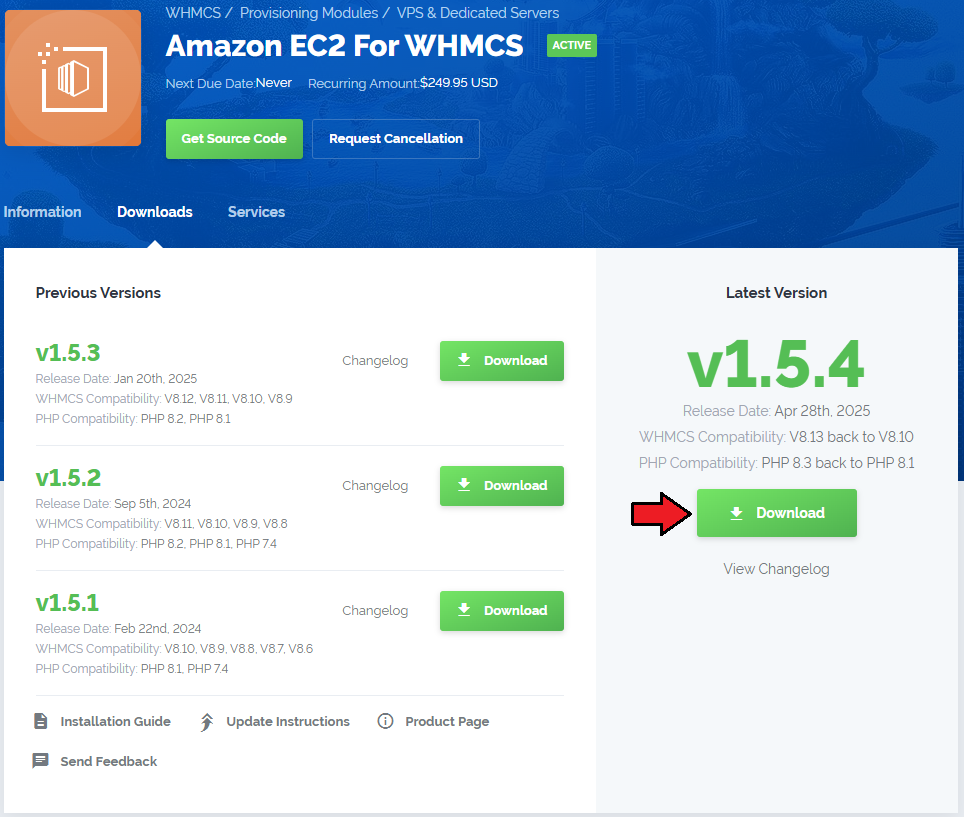
|
| 2. Upload and extract the extension into the main WHMCS directory. Extracted files in your WHMCS directory should look like this: |
| 3. When you install Amazon EC2 For WHMCS for the first time, you have to rename the 'license_RENAME.php' file. The file is located in '/yourWHMCS/modules/servers/AwsEc2/license_RENAME.php'. Rename it from 'license_RENAME.php' to 'license.php'. |
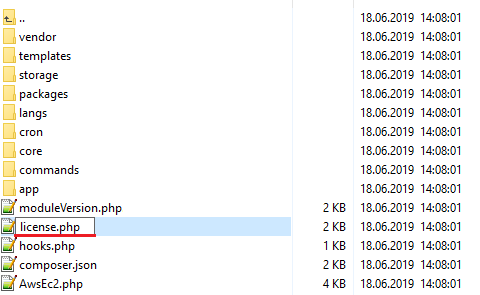
|
| 4. In order to configure your license key, you have to edit the previously renamed 'license.php' file. Enter your license key between the quotation marks as presented on the following screen. |

|
| 5. Now, set up the 'storage' folder as recursively writable. This folder is available at '/yourWHMCS/modules/servers/AwsEc2/'. |
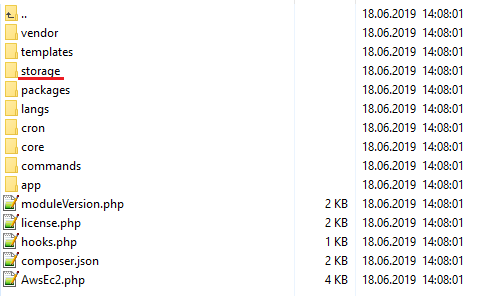
|
| 6. The last step is setting up the queue cron job. It will be used to execute module commands such as: create, terminate or change package. php -q /yourWHMCS/modules/servers/AwsEc2/cron/cron.php queue It is suggested to run the cron every 5 minutes. |
[edit] Configuration of Server
| Before you can go on, you must generate your Amazon EC2 access details. You will need them to connect with the server successfully. Underneath, you will find instructions where to find them. |
| 7. Firstly, log into your Amazon EC2 account and find 'My Security Credentials' section under your account name dropdown. |
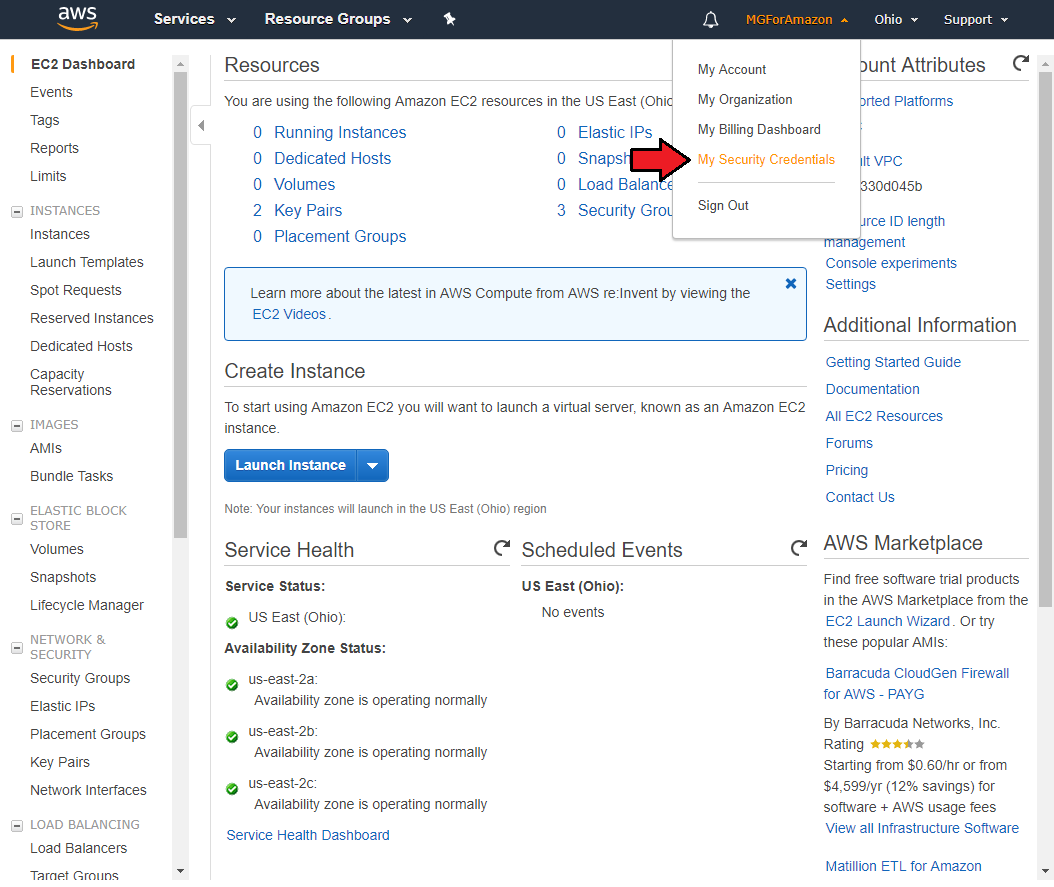
|
| 8. There, move to 'Access Keys (access key ID and secret access key) section. |
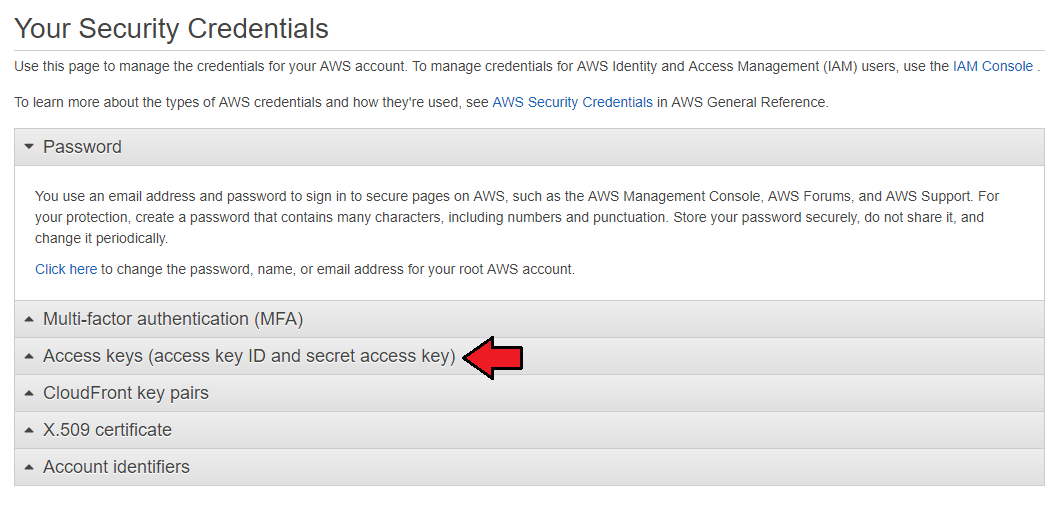
|
| 9. If you do not have yet any active keys, then press 'Create New Access Key' button to generate a new set of details. |
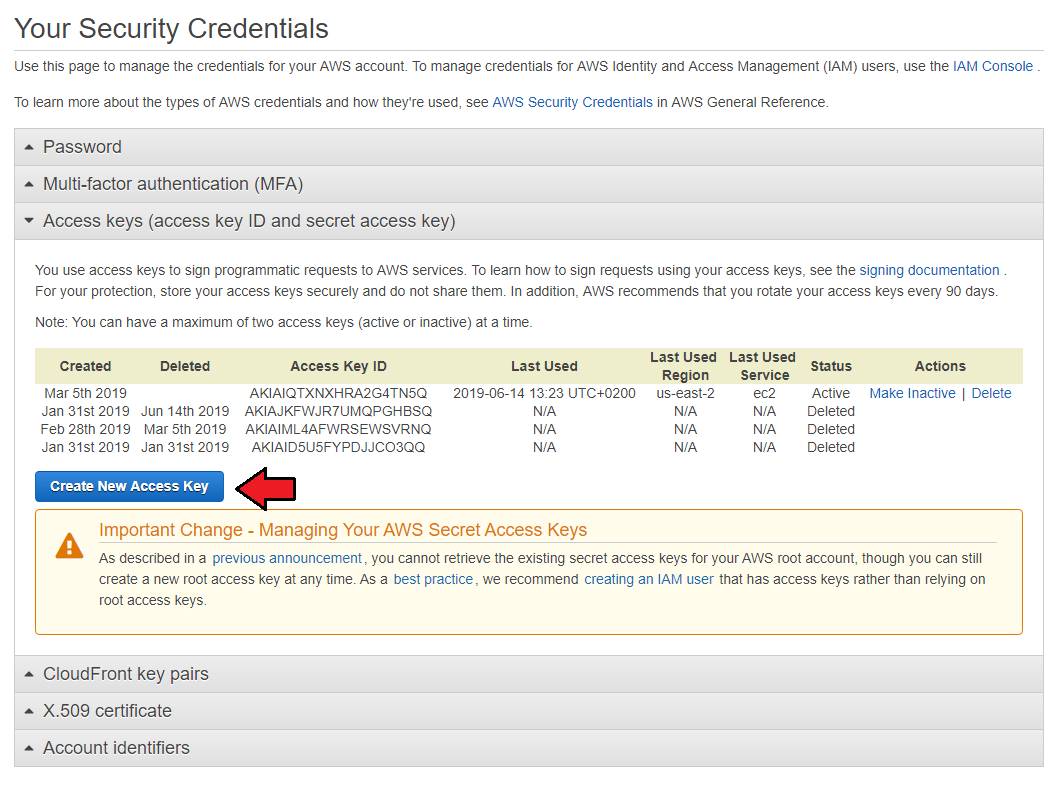
|
| 10. A modal with Access Key ID and Secret Access Key will appear, so copy it and keep safe. You may also download a file with the details. Note that this is the only place where you can later on find the corresponding secret key, it will not be visible next to the Key ID in the panel. |
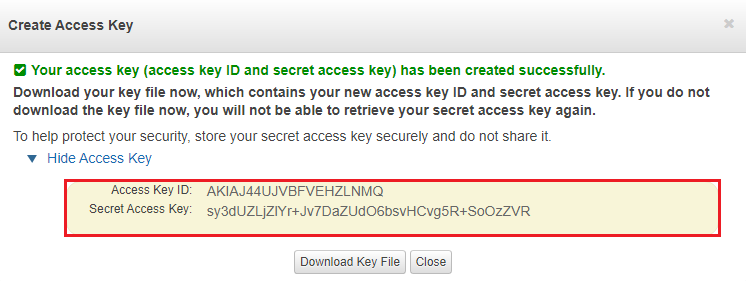
|
| 11. Now, log in to your WHMCS and proceed to 'Setup' → 'Products/Services' → 'Servers' and press 'Add New Server'. |
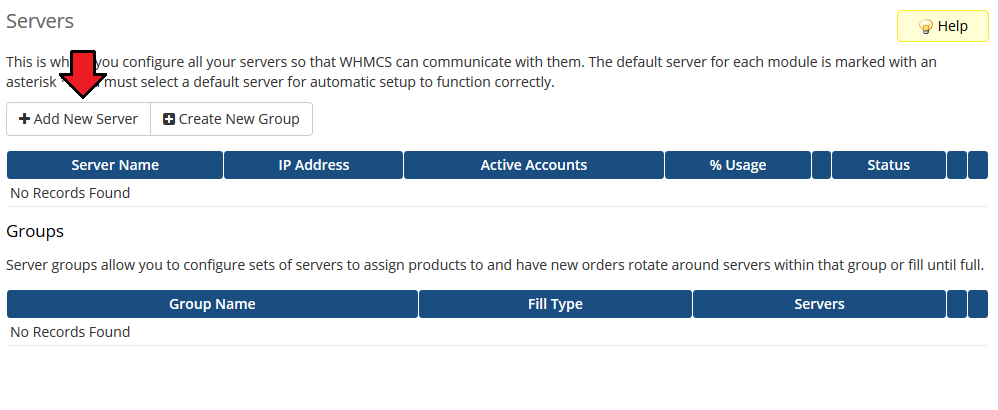
|
| 12. Next, enter your server name and select 'Amazon EC2' from the 'Type' field. Now, provide the previously generated 'Access Key ID' and 'Secret Access Key'. Then check the connection. If successful, save the changes. |
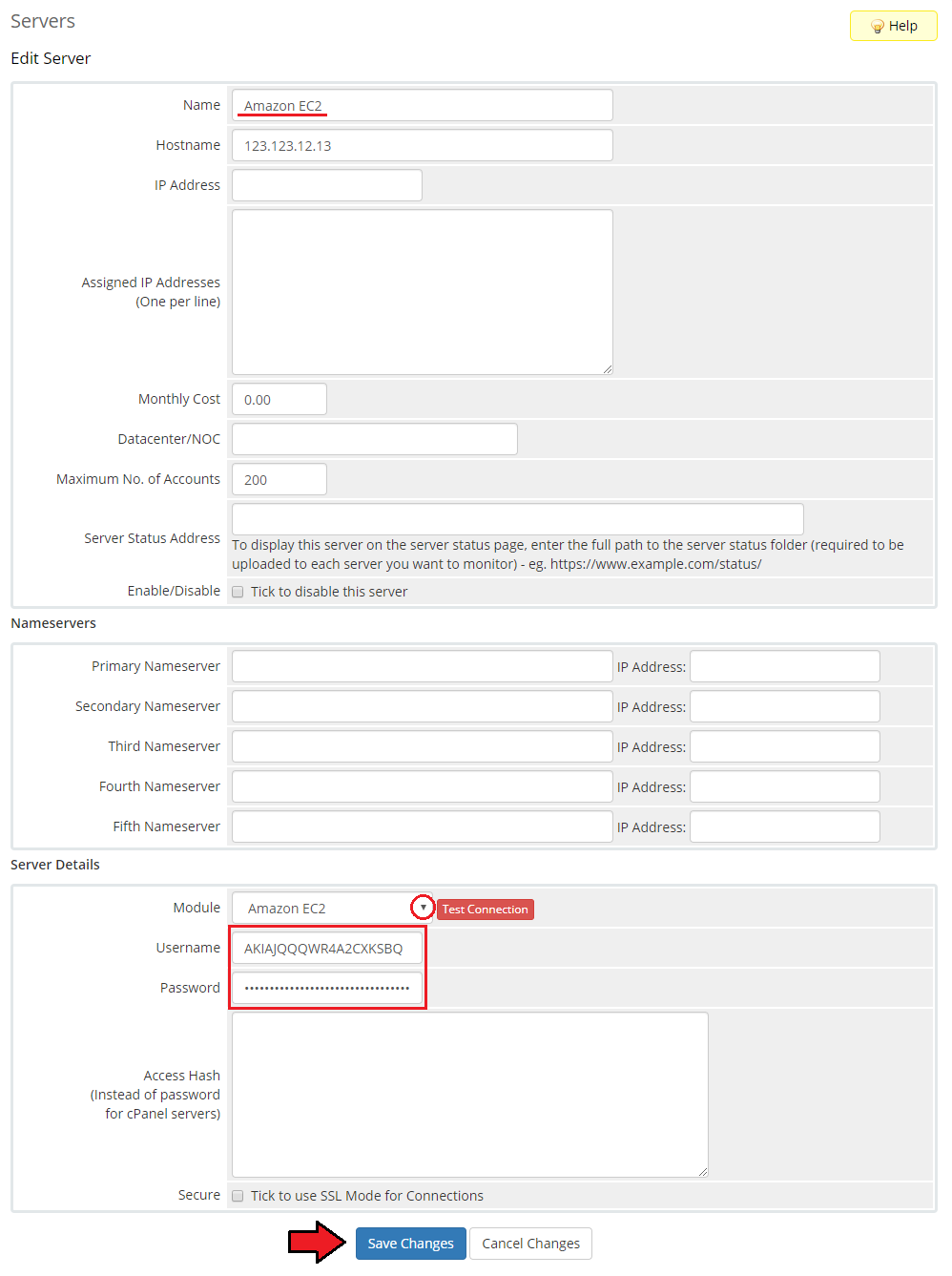
|
| 13. It is time to create a server group. To do so, click on 'Create New Group' . |
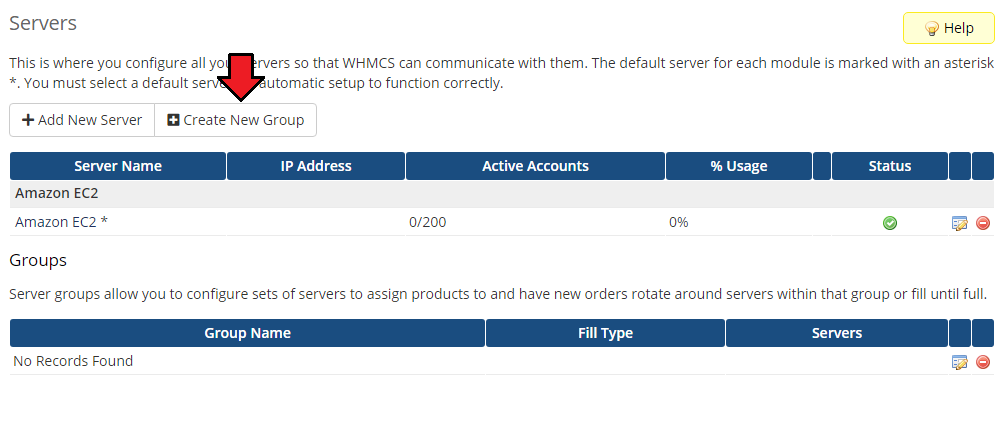
|
| 14. Enter a name, click on your previously created server, press 'Add' and afterward 'Save Changes' . |
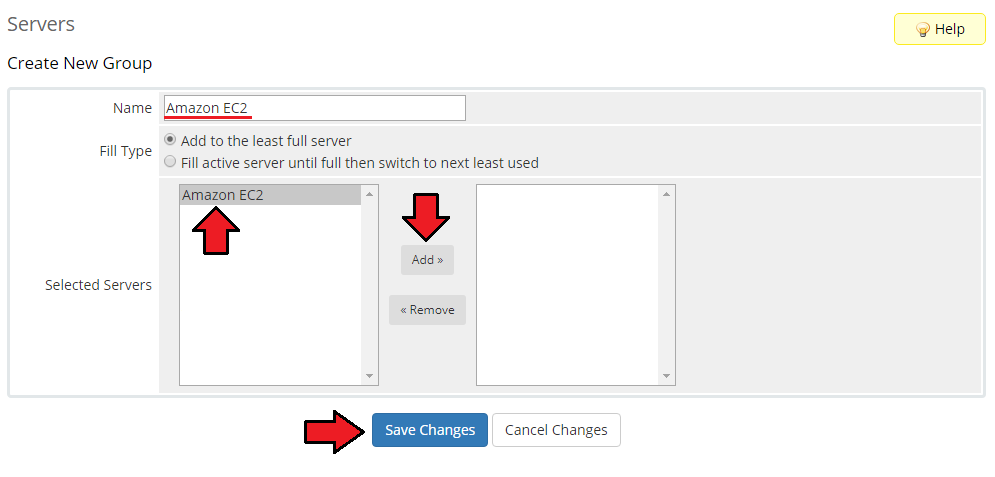
|
[edit] Configuration of Product
| 15. In order to create and configure a product, go to 'Setup' → 'Products/Services' → 'Products/Services'. Click on 'Create a New Group'. |

|
| 16. Enter your product group name and press 'Save Changes'. |
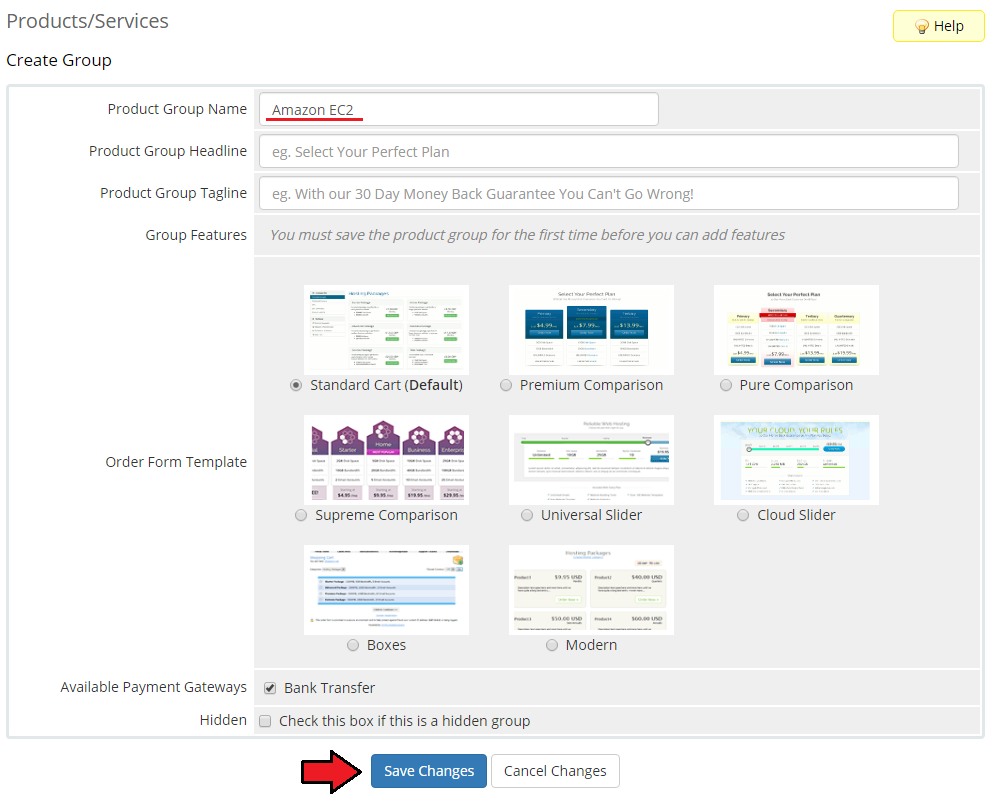
|
| 17. Once you have a product group, you can create a new product. To do so, first click on 'Create a New Product'. |

|
| 18. Afterward, choose your product type, enter your product name, choose module and the product group from the dropdown menus. Press 'Continue'. |
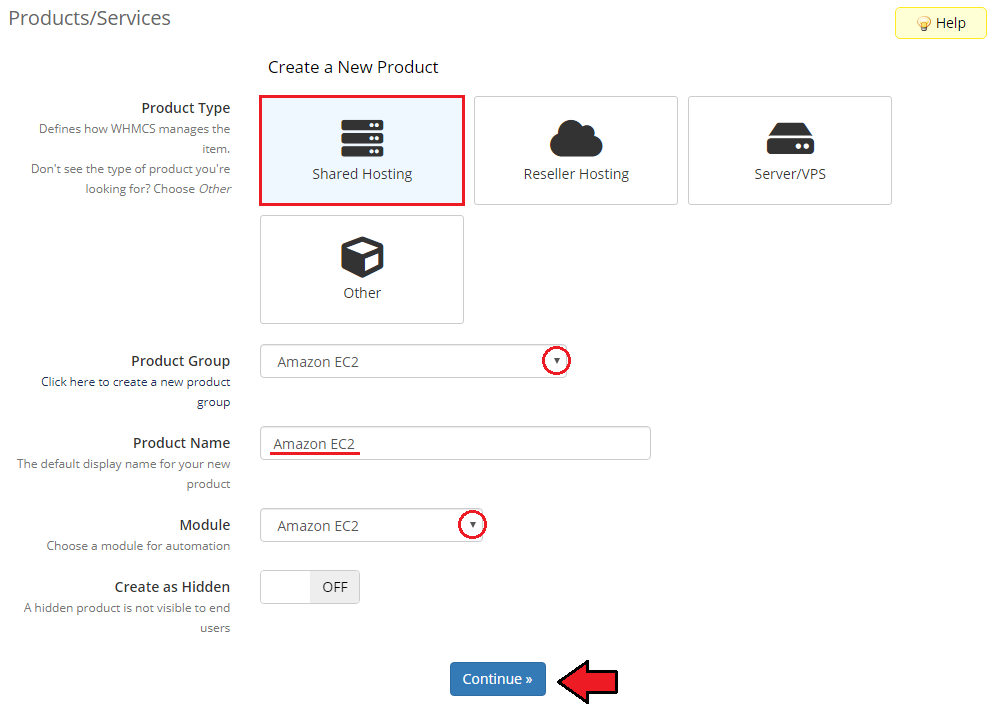
|
| 19. Now, go to the 'Module Settings' section, choose your previously created server group from the dropdown menu. The module should automatically save and reload the settings. If not, click on the 'Save Changes' option manually. |
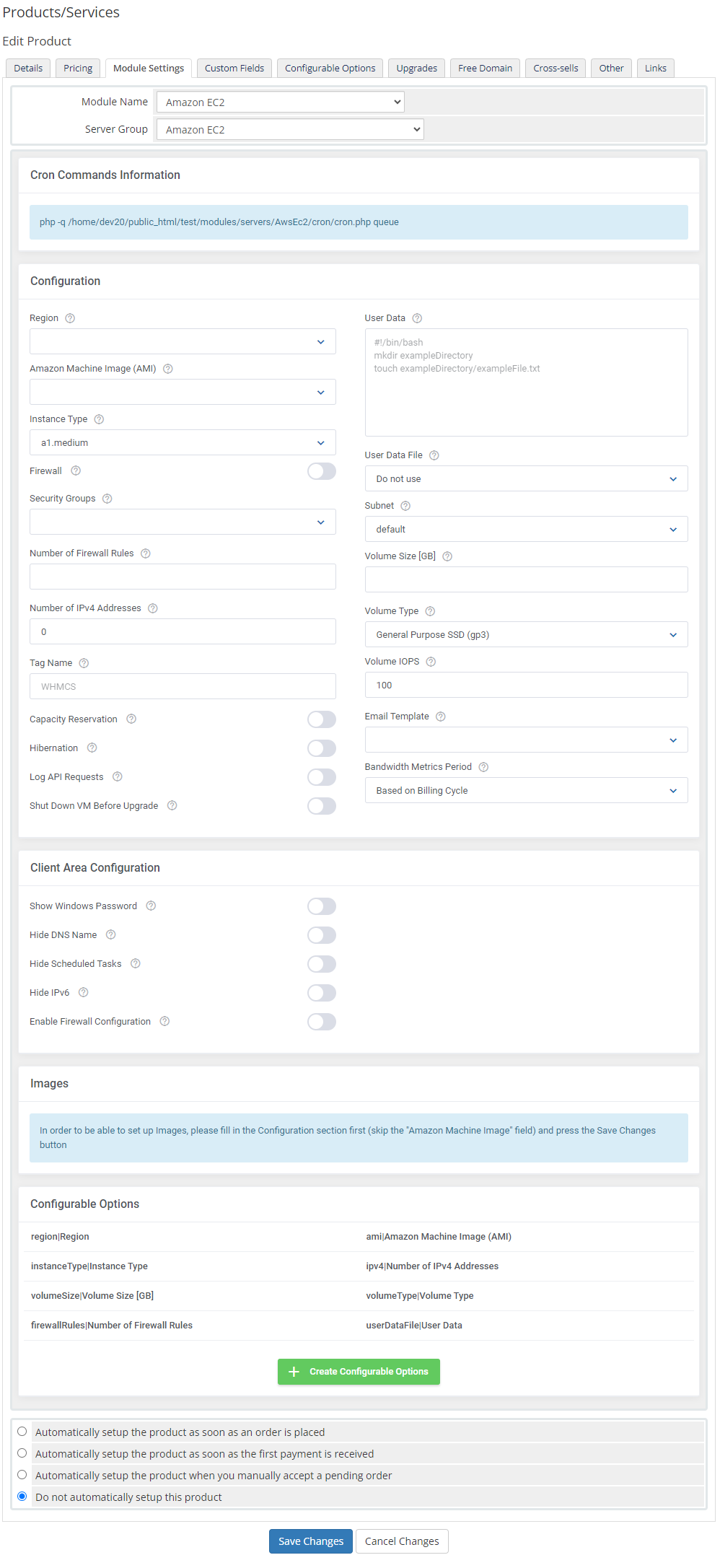
|
| 20. Now, you can start configuring the settings of the server you sell. Just like when creating a new virtual machine in your EC2 panel, here also you can configure such options as:
Client Area Configuration:
|
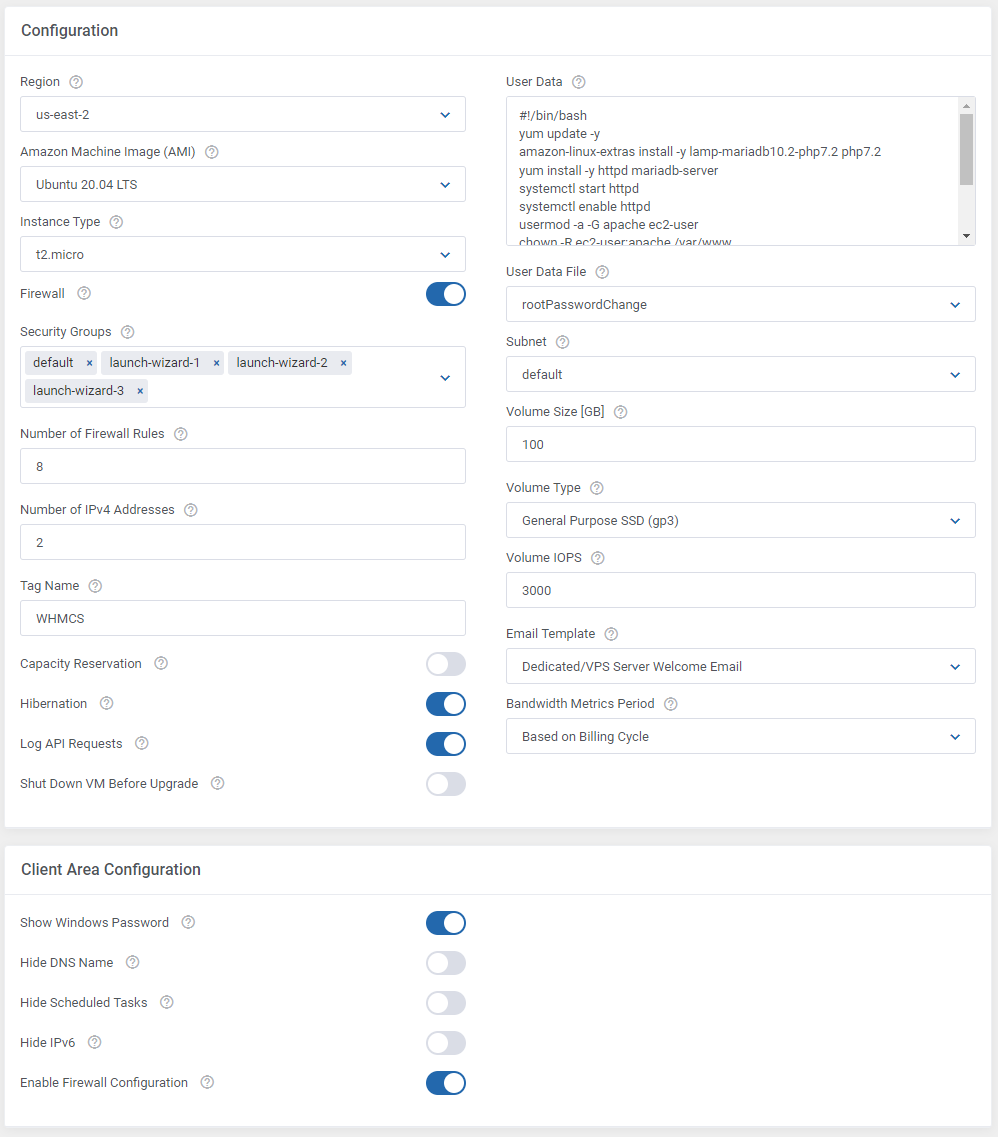
|
| 21. The following section is dedicated to Images. Here, you may look for and then select single images to be added to the list. They will be available to choose from in the Amazon Machine Images (AMI) field in the main configuration of the product. First of all, enter as many details as possible to find the images you are interested in. Press the search button when ready. |
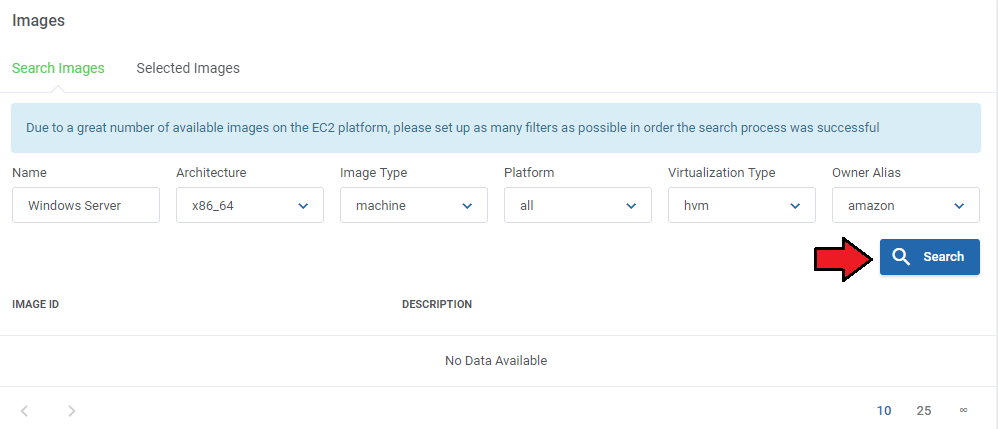
|
| When the list of available images appears, press 'Add' next to the one you wish to add to the list of selected. |
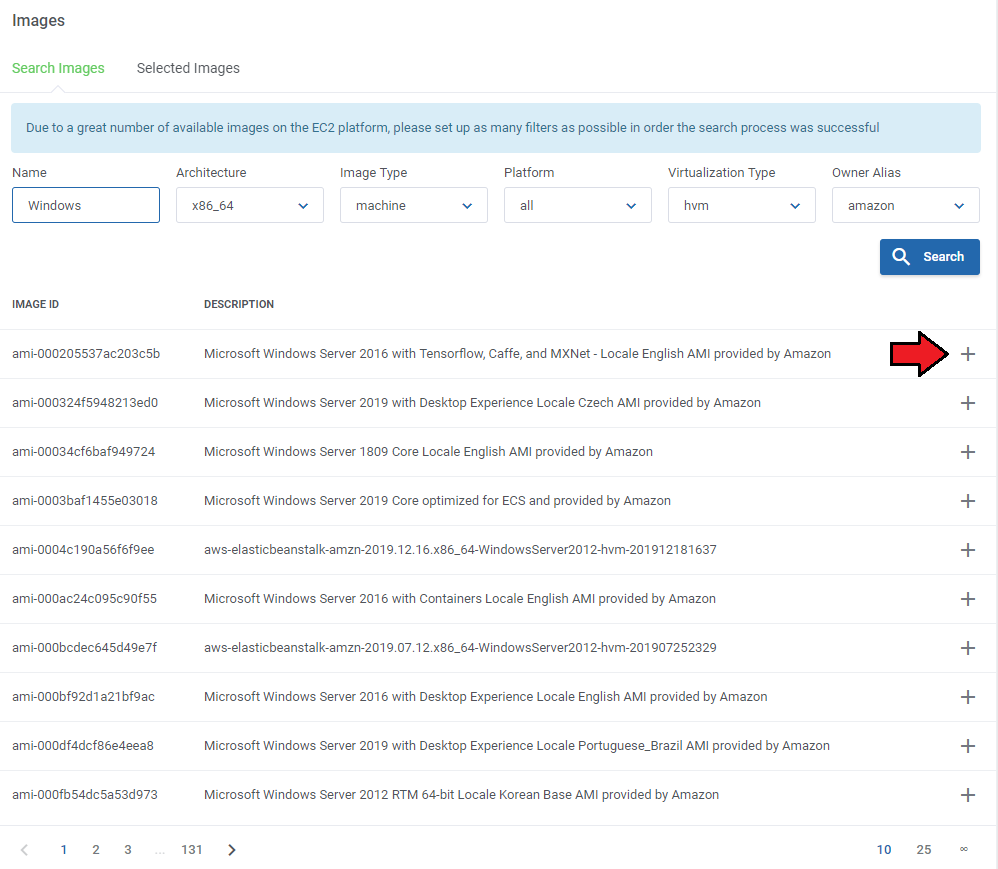
|
| Enter a custom name if you wish and confirm the action. |
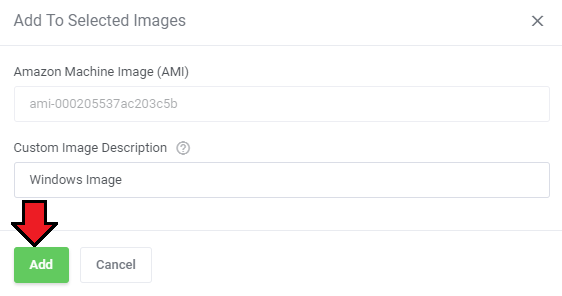
|
| On the list of selected, there are all images that you have added, and which will be available to select from when setting up the Amazon Machine Images (AMI) configuration field. It is also possible to add images manually here. Simply enter the image ID. |
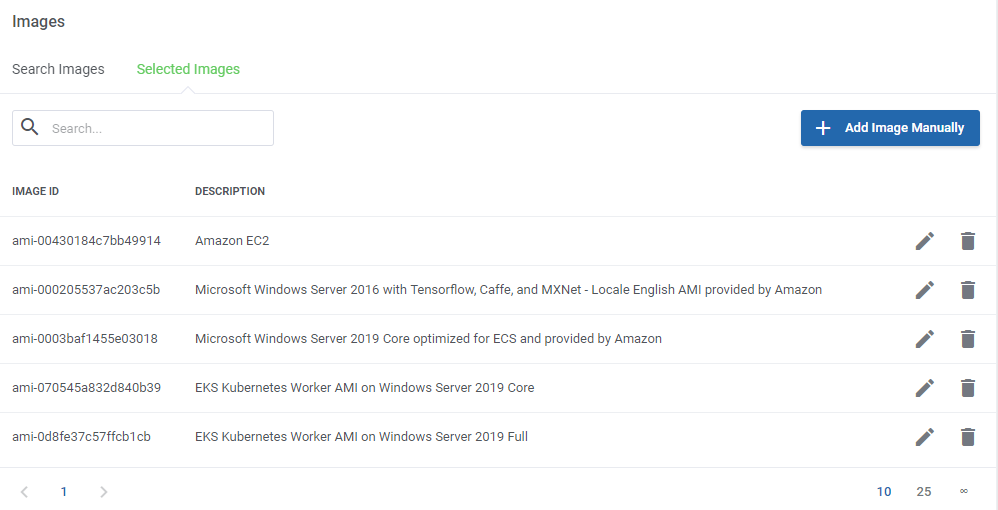
|
| When found, press the 'Add' button. |
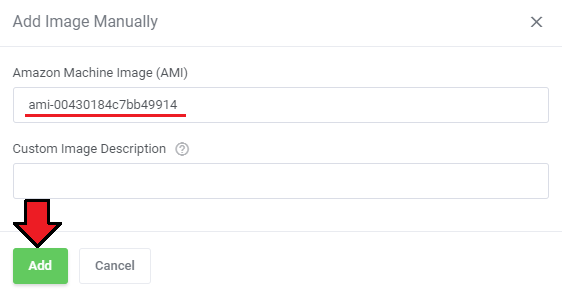
|
| 22. At the end of the configuration process, you can decide whether you want to generate configurable options for the product. Configurable options can be used by your clients to select each virtual machine parameters individually during order placement. |

|
| If you decide to use configurable options, press on the 'Create' button and select which options you want to generate. Note that the configuration for disabled options will still be taken from the configuration of the main product. More information about how to use configurable options can be found here or in the official WHMCS documentation. |
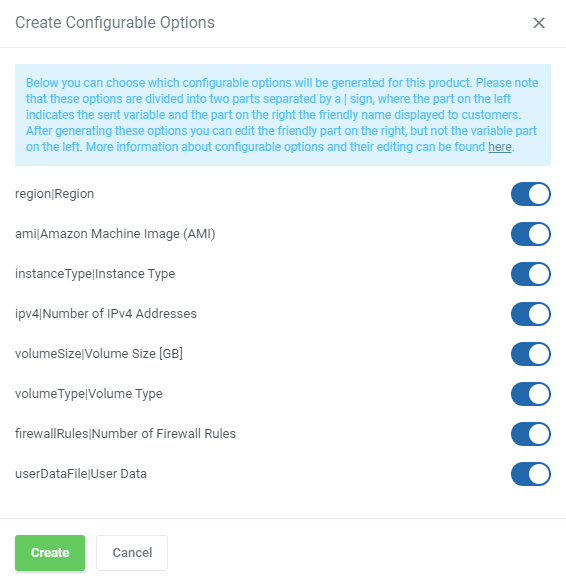
|
[edit] SSH Keys
| In the 'Custom Fields' tab you will find the 'SSH Public Key' field which is displayed to clients on the order form by default. The following formats are supported:
Create an RSA key. Amazon EC2 does not accept DSA keys. The supported lengths are 1024, 2048, and 4096. If you would like to limit the possibility of entering the key e.g. only to the 'ssh-rsa' format, you can use the regular expression in the validation field, such as: #ssh-rsa AAAA[0-9A-Za-z+/]+[=]{0,3}( [^@]+@[^@]+)?#
Remember that API allows such action only once, during the initial VM creation. |
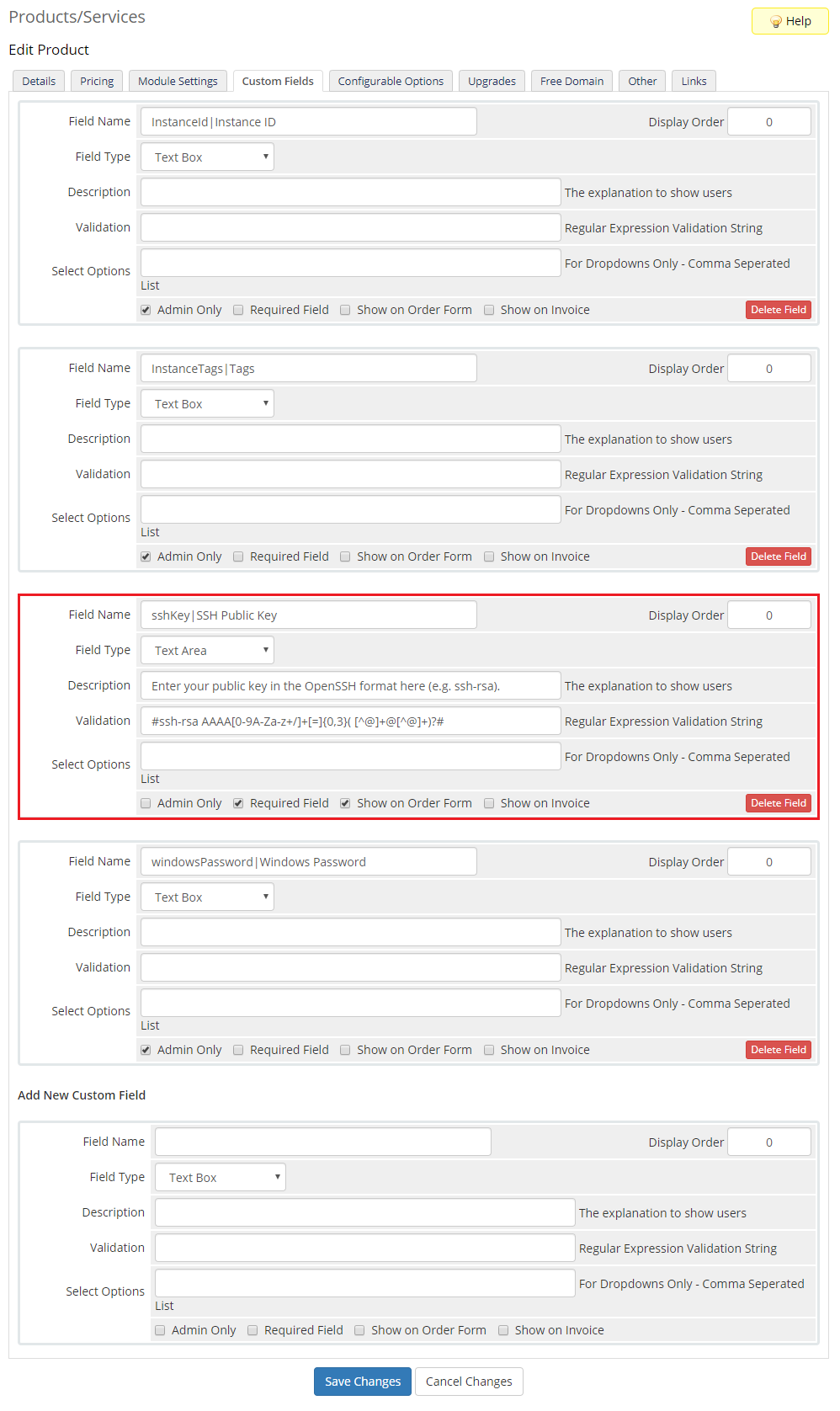
|
[edit] User Data Scripts
| User data is arbitrary data that can be executed during Amazon EC2 virtual machine creation, typically during the first boot of the server. This allows you to perform tasks or run scripts as the root user which can be extremely useful when provisioning a server. You can provide your own scripts using 'cloud-config' or 'Bash', keep in mind that module parameters are supported and may be used in the script files. |

|
| Once you create your own script, it can be chosen for product execution. You can provide multiple scripts for configurable options, but only one can be chosen for Amazon EC2 server creation. |
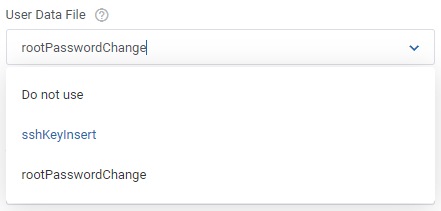
|
[edit] Management
[edit] Admin Area
| Amazon EC2 For WHMCS allows you to monitor and manage your customer server instance from the admin area of your WHMCS system. This includes supervision of such features as:
|
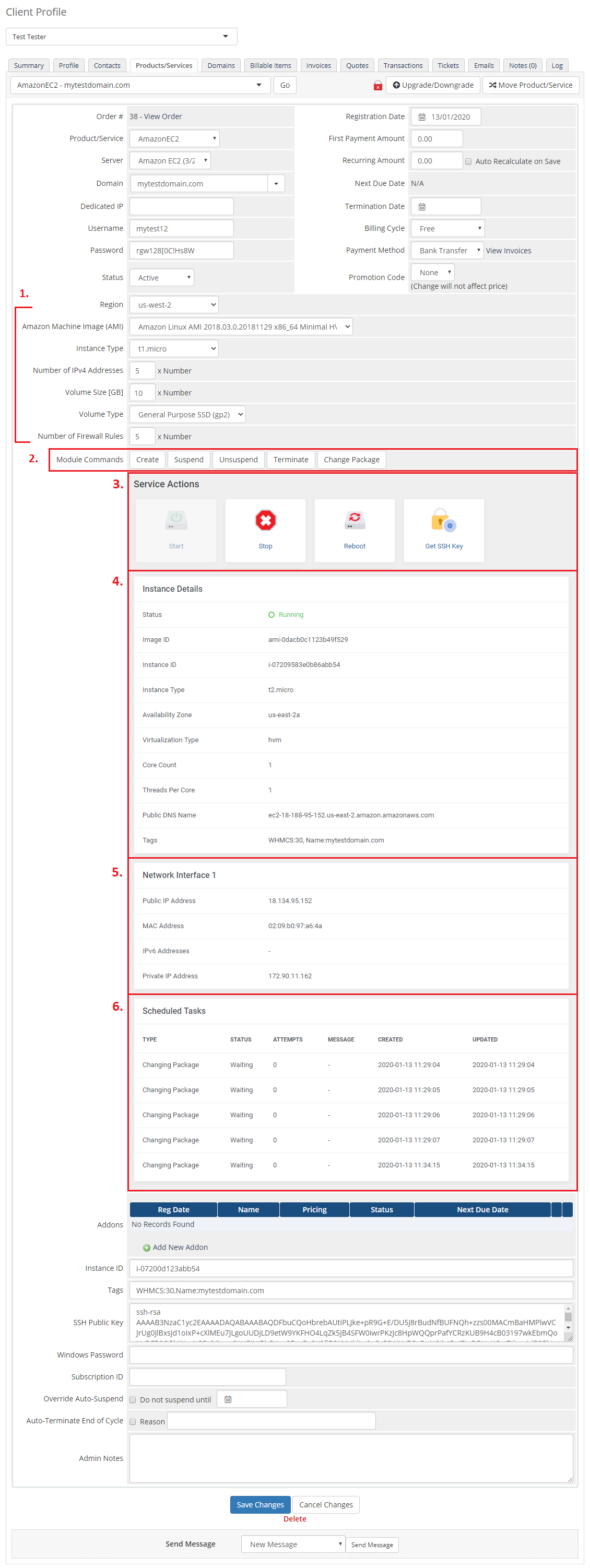
|
[edit] Ordering
| Thanks to configurable options, you are able to offer a product which your clients can tailor according to their needs. Additionally, you are able to set up pricing for each configurable option, which makes your offer even more competitive. At this moment you also have to provide the SSH key. Note that this key should be in one of the OpenSSH standard formats which are supported by API, e.g. ssh-rsa. |
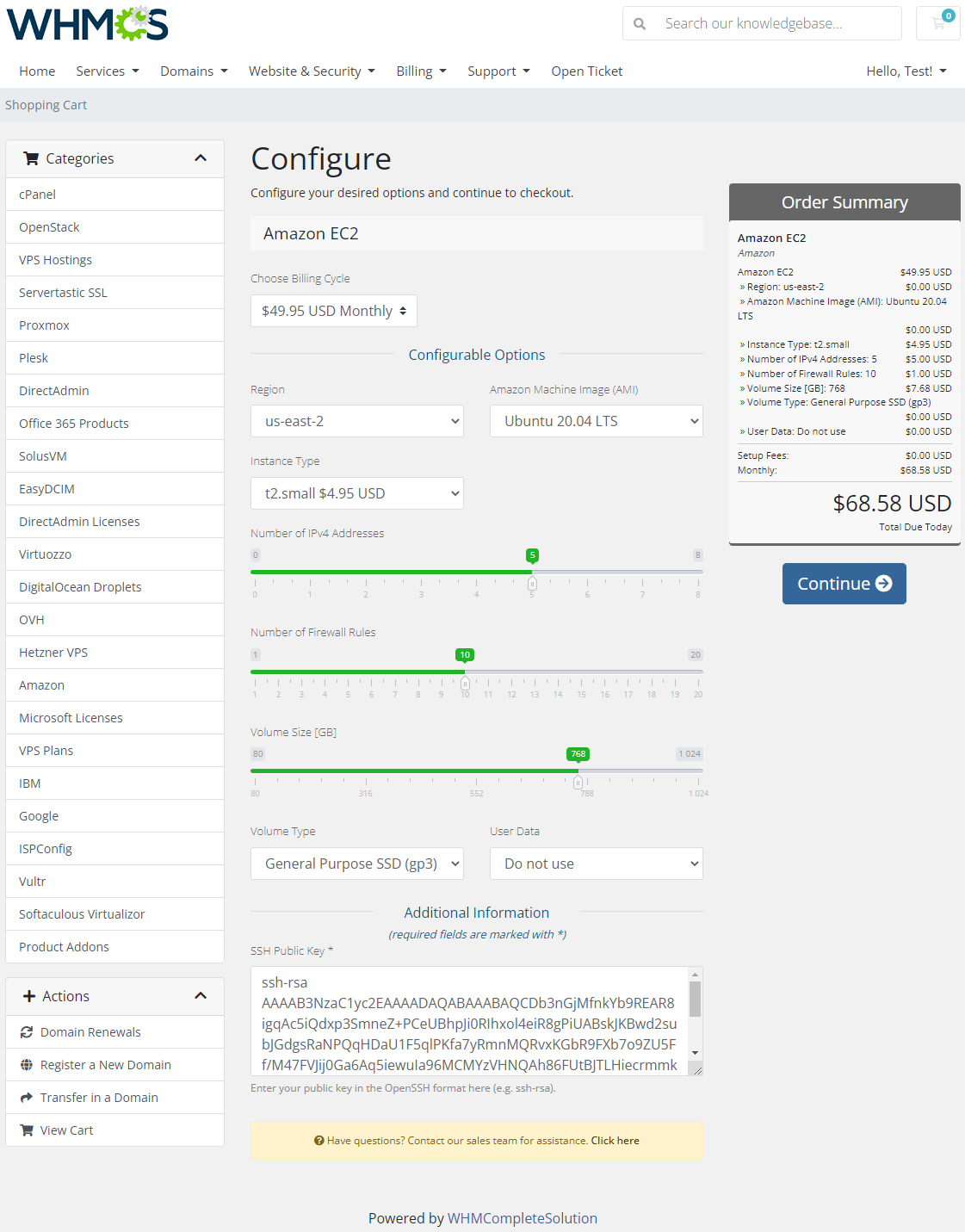
|
[edit] Importing Existing Instance
| In this section, you can find short instruction on how to connect one of your clients to your already existing instance in the Amazon EC2 panel. Take the following steps to make sure that the process will be carried out properly. 1. Firstly, manually create an order for your customer in WHMCS. Choose a client and in the summary, view click on the ' Add New Order' button. Next, select a 'Product/Service' and press 'Submit Order' .
The above-mentioned information has to be consistent with the data from your Amazon EC2 panel. Now, complete these fields as presented below. |
| 3. If the completed data is correct, after refreshing the page, you will see the attached instance from Amazon EC2. Important! Remember to manually add other missing parameters of the instance such as domains, credentials, IP Addresses, configurable options, SSH Key, billing cycle, etc. so they match the parameters of the attached instance from Amazon EC2. |
[edit] Client Area
| The client area interface of Amazon EC2 should look like the one on the screen below. As you can see, the control panel contains useful details of the managed server. The module allows your customers to easily start, stop and reboot their server instance through pressing the corresponding buttons. |
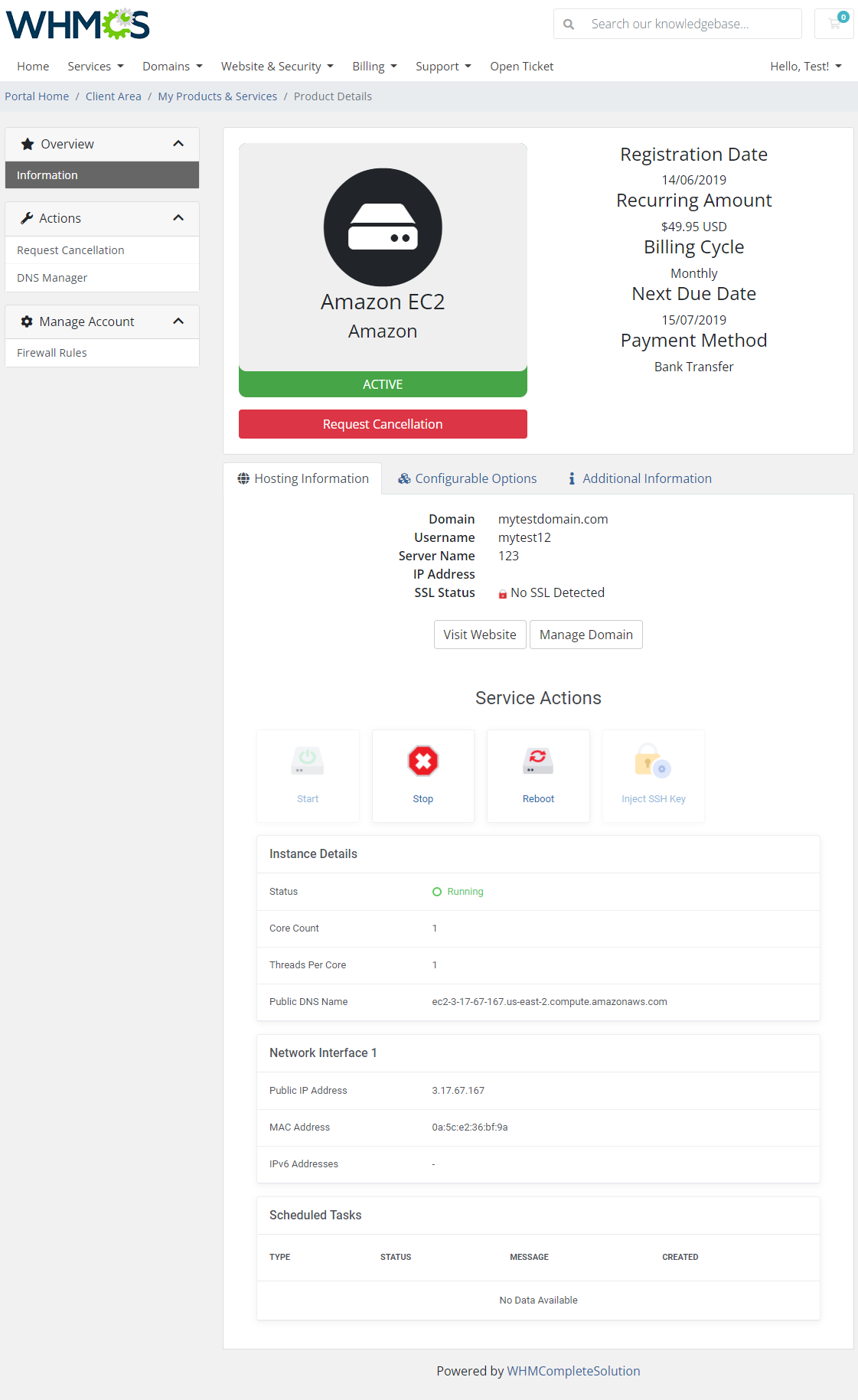
|
[edit] Firewall Rules
| Under the 'Firewall Rules' section, you may quickly add as well as remove 'Firewall Rules' . Note: Please remember that if the 'Add' button is unavailable, you have probably reached the rule limit set by the administrator. |
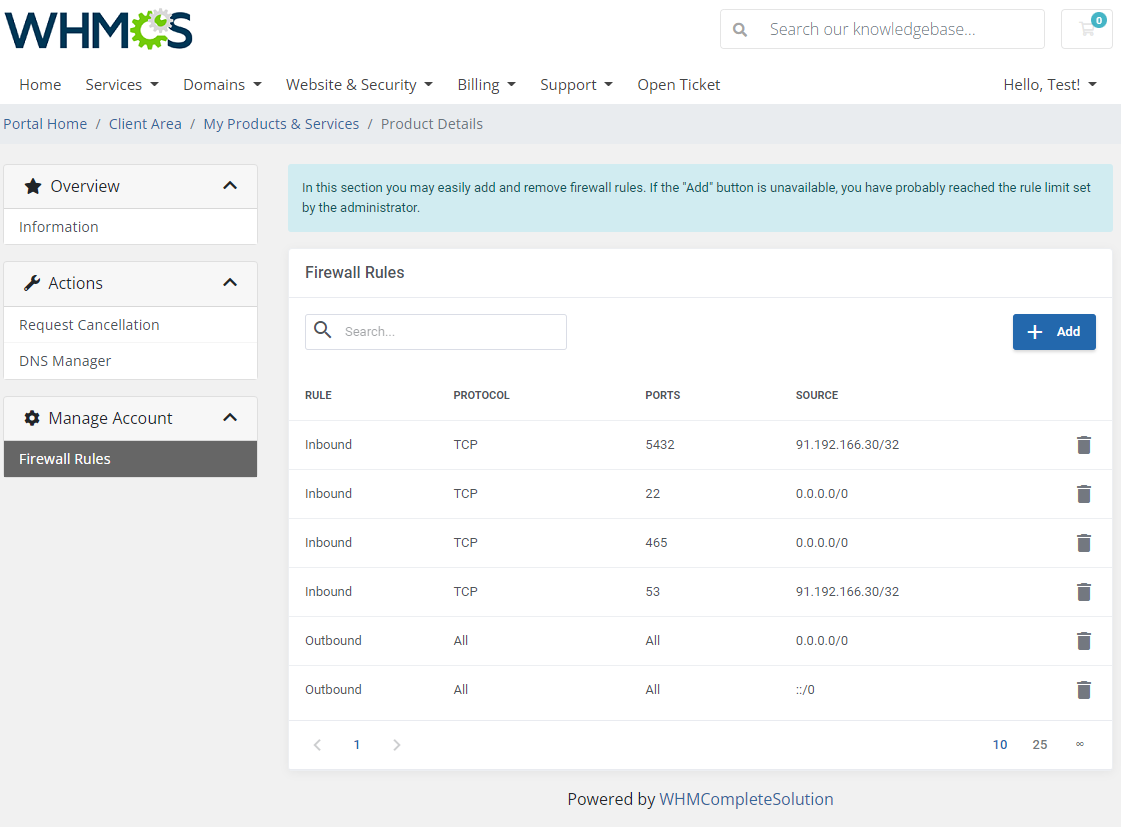
|
| Complete the details of your new security group rule and confirm by clicking 'Add' . |
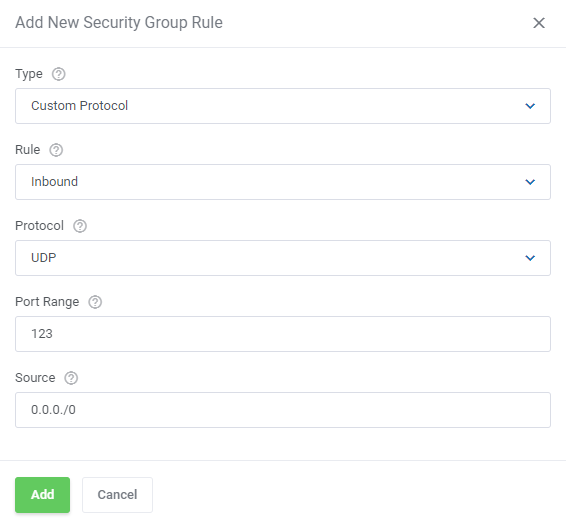
|
[edit] Tips
| 1. You must firstly stop the machine to let the change package action be successfully completed. |
| 2. In case you need to generate any of the configurable options once again, you must delete the previously created one. Only then it will be possible to generate a new configurable option. Read more about configurable options here. |
| 3. Amazon EC2 module supports all the default WHMCS marge field variables, they can be freely used in the welcome email template. Read more about module parameters here. The module also supports the below listed AWS variables: 'AmiLaunchIndex', 'ImageId', 'InstanceId', 'InstanceType', 'KeyName', 'Monitoring_State', 'Placement_AvailabilityZone', 'Placement_GroupName', 'Placement_Tenancy', 'PrivateDnsName', 'PrivateIpAddress', 'ProductCodes', 'PublicDnsName', 'State_Code', 'State_Name', 'StateTransitionReason', 'SubnetId', 'VpcId', 'Architecture', 'BlockDeviceMappings', 'ClientToken', 'EbsOptimized', 'EnaSupport', 'Hypervisor', 'NetworkInterfaces_0_Attachment_AttachmentId', 'NetworkInterfaces_0_Attachment_DeleteOnTermination', 'NetworkInterfaces_0_Attachment_DeviceIndex', 'NetworkInterfaces_0_Attachment_Status', 'NetworkInterfaces_0_Description', 'NetworkInterfaces_0_Groups_0_GroupName', 'NetworkInterfaces_0_Groups_0_GroupId', 'NetworkInterfaces_0_Ipv6Addresses', 'NetworkInterfaces_0_MacAddress', 'NetworkInterfaces_0_NetworkInterfaceId', 'NetworkInterfaces_0_OwnerId', 'NetworkInterfaces_0_PrivateDnsName', 'NetworkInterfaces_0_PrivateIpAddress', 'NetworkInterfaces_0_PrivateIpAddresses_0_Primary', 'NetworkInterfaces_0_PrivateIpAddresses_0_PrivateDnsName', 'NetworkInterfaces_0_PrivateIpAddresses_0_PrivateIpAddress', 'NetworkInterfaces_0_SourceDestCheck', 'NetworkInterfaces_0_Status', 'NetworkInterfaces_0_SubnetId', 'NetworkInterfaces_0_VpcId', 'NetworkInterfaces_0_InterfaceType', 'RootDeviceName', 'RootDeviceType', 'SecurityGroups_0_GroupName', 'SecurityGroups_0_GroupId', 'SourceDestCheck', 'StateReason_Code', 'StateReason_Message', 'Tags_0_Key', 'Tags_0_Value', 'Tags_1_Key', 'Tags_1_Value', 'VirtualizationType', 'CpuOptions_CoreCount', 'CpuOptions_ThreadsPerCore', 'CapacityReservationSpecification_CapacityReservationPreference', 'HibernationOptions_Configured', 'MetadataOptions_State', 'MetadataOptions_HttpTokens', 'MetadataOptions_HttpPutResponseHopLimit', 'MetadataOptions_HttpEndpoint' |
4. Utilizing the 'Show Windows Password' option in the Client Area:
|
| 5. When creating a virtual machine without a firewall but with a security group (other than the default), you won't be able to activate the firewall rules through the module. This action is only possible directly within the panel. |
[edit] Update Instructions
| An essential guidance through the process of updating the module is offered here. Ensure successful completion of the module update by carefully following each step, thereby preventing data loss or any unforeseen issues. |
[edit] Upgrade Guide
| Seeking a solution that offers greater flexibility, customization tailored to your precise needs, and unrestricted availability? There is an option that not only proves to be cost-effective in the long run but also includes prioritized support services, making it a truly valuable investment. Opt for the Open Source version of your Amazon EC2 For WHMCS module to unlock these benefits. Follow a comprehensive guide covering the transition process, the advantages it brings, and step-by-step instructions on what to do next after the order has been successfully finalized. |
[edit] Common Problems
| 1. When you have problems with connection, check whether your SELinux or firewall does not block ports. |